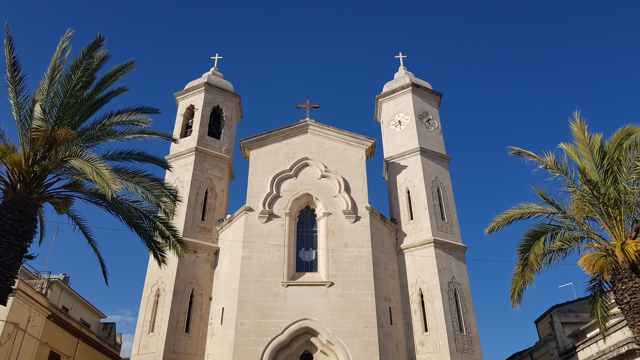Chiesa del Ss. Crocifisso (1935)

IT - Ricavata da un antico magazzino agricolo agli esordi del settecento, fu la prima Chiesa Madre di Rosolini.
Nel 1935, grazie alla caparbietà del parroco Murana e ai numerosi contributi dei devoti emigrati rosolinesi, fu ricostruita su progetto dell’architetto Terranova, secondo uno stile gotico-moresco.
Al suo interno, sopra l’altare, è collocata la Croce lignea, ritrovata in una grotta a circa due chilometri dal paese, nella quale sono dipinti il Cristo coronato di spine già morto e la scritta «
In tempore necessitatis, petite et accipietis»:
in un momento di bisogno, chiedi e riceverai.
Il 3 maggio di ogni anno, nell’ambito dei festeggiamenti con i quali si celebra il suo ritrovamento, la Croce viene condotta in processione nella grotta in cui fu ritrovata.
Sotto il pavimento della Chiesa, i loculi danno sepoltura ai rosolinesi deceduti prima del 1843 e ricordati nella lapide commemorativa posta al centro dello stesso.
Nella navata di destra, di particolare interesse, la scultura dell’artista Biagio Poidimani «
La deposizione di Cristo», mentre, sul soppalco sopra l’ingresso, si può apprezzare l’organo a canne del 1936 del maestro organaro Michele Polizzi.
Testo di Salvatore SPADARO
EN - Transformed from an ancient agricultural warehouse at the beginning of the eighteenth century, the Church of the Holy Crucifix became the first Mother Church in Rosolini.
In 1935, thanks to the stubbornness of the parish priest Morana and the numerous contributions of the devoted emigrants from Rosolini, it was rebuilt, according to the project of the architect Terranova, in a Gothic-Moorish style.
Inside the church, above the altar, there is the wooden cross which was found in a cave about two kilometres far from the town. There are some paintings on the cross itself; the already dead Christ crowned with thorn crown and the latin inscription "In tempore necessitatis, petite et accipietis"that means " in a time of need ask and you will receive what you ask for".
Annually, on May 3rd , as part of the celebration of its discovery, the Cross is carried in procession up to the cave where it was found in the past.
The inhabitants who died before 1843 are buried underneath the floor of the Church,they are mentioned in the commemorative tombstone placed in the center of the same church.
In the right aisle there is the particularly interesting sculpture by Biagio Poidimani; "The Deposition of Christ". And, on the mezzanine above the entrance, the 1936 pipe organ by Michele Polizzi can be admired.
